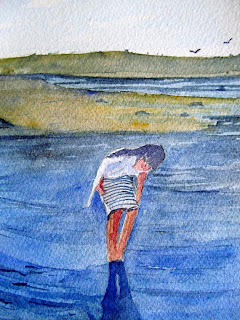 |
| (C) 2015 Dale DiMauro |
Since we arrived in Maine, I started this watercolor of a lobster boat. I do not have a ton of experience painting coastal scenes but have been eager for some time to give to it my best shot. I find I am laying out less of the picture in pencil, but if needed, will draw a little as I get into any uncertain areas. However, in watercolor it is advisable to lay out the picture in advance. There definitely are some flaws to the picture, in particular where I let a pigment run a bit, but overall there is a cool blue feel which is good on a July summer day. Recently, I was studying some of Winslow Homer's coastal scenes in his watercolors where he uses very free washes for the sky and thus attempted his approach above.
Some artists use very clean palettes but I am not one of those. I let different pigments mix with others from a prior painting and that is in part, one way I learn new color combinations. In the sky above, there was some red that was in one of my blue painting wells so I couldn't be fussy and had to work with it, once it was on the paper. Basically, I could lift the color from the paper with a paper towel, dilute it with water or embrace the 'happy accident' and learn from it.
I have been experimenting with a new color I purchased when we were at the Art Mart in Portland, Maine last week. This color is 'shadow green' which can be seen in varying degrees in the water around the boat even though it is mixed with payne's gray and indigo in other areas.









